Cable cars on Castro? An ‘elevated’ railway at Harvey Milk Plaza? Four streetcar tracks on Market? It’s all part of the transit history in a San Francisco neighborhood that has truly seen it all over the years.
What the heck is a steam dummy?
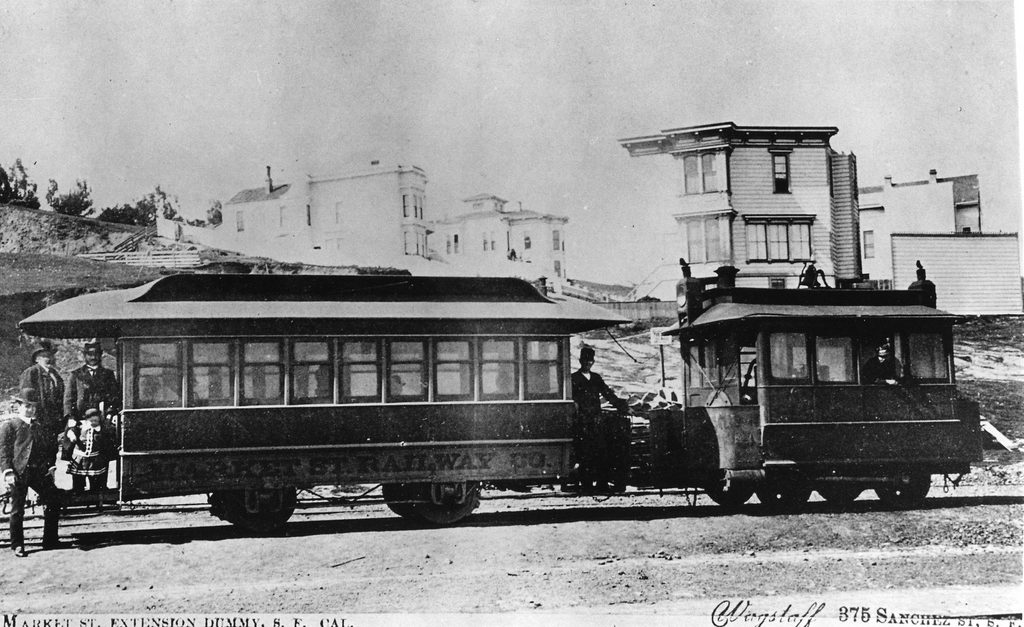
That’s one, right there, on Market at Castro in the 1880s, looking north from where the Chevron station is now. The little box on the right, called the dummy, holds a steam engine and the operator. The trailer holds the passengers. They had to dynamite the hill next to where the Mint stands now, at Duboce Avenue, to cut Market through from downtown. The Market Street Cable Railway Co. ran this steam dummy for several years to connect with cable car service to the Ferry Building at Valencia Street. (A similar steam dummy ran on Market Street downtown for a few years starting in 1860 but the noise drove people nuts on the crowded street.
The neighborhood cable cars built
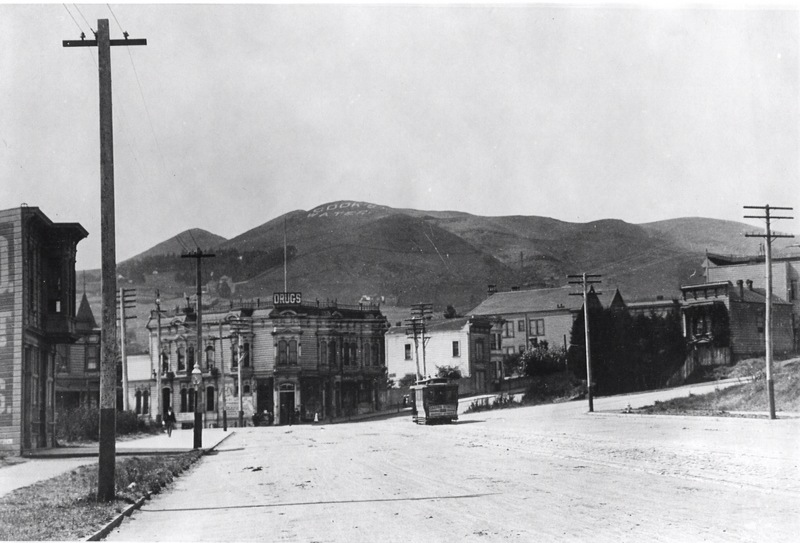
No crowds in Eureka Valley (as The Castro was then called) back when the Market Street Cable Railway Company, owned by Southern Pacific interests, replaced the steam dummy in 1887 with a direct cable car line from the Ferry to Castro on Market, then over the hill on Castro to 26th Street in Noe Valley. The shot above, from the 1890s, looks along Market west of Noe toward Twin Peaks. The ornate building just left of the cable car is the site of the later Bank of America building (now occupied by Soulcycle). The Castro cable line completed the Market Street cable car network, with most of those routes surviving even today as large portions of Muni’s 5, 7, and 21 trolley bus lines, and the F-Market streetcar.
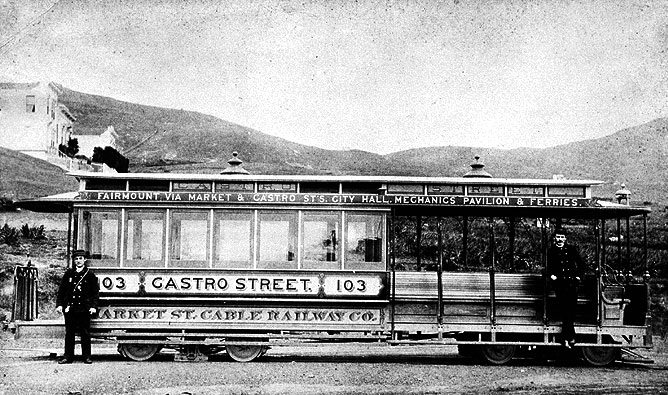
Each of the Market Street cable lines had different colored cars, so riders downtown could see their car from a distance. Castro cable cars were ivory (Valencia was blue, Haight red, McAllister yellow, Hayes green).
The coming of the cable car and its speedy (9mph) trip downtown brought a building boom along its route on outer Market and over the Castro Hill into Valley. Victorian row houses marched up the streets within walking distance of a car stop. More remote blocks atop Dolores Heights took decades longer to develop for lack of public transit.
Electric streetcars take over

The 1906 Earthquake ended an era for the Castro as well as the City. While the buildings of the neighborhood survived, the Market Street cable system was badly damaged. United Railroads (URR), by then the owner, had for years wanted to replace the cables on Market with faster electric streetcars, but had met resistance from those who considered overhead trolley wires to be unsightly. In the confusion following the earthquake, URR’s owners took a straightforward approach to get what they wanted. They bribed the entire Board of Supervisors. Within weeks, the wires were up on Market and streetcars reached the Castro, numbered as the 8-line. (The two cars above are on Market at 16th Street in 1917.) But from 18th Street south, the Castro hill was too steep for streetcars. So that portion of the cable line was left in place as a kind of shuttle.
Along Comes Muni

The obvious corruption surrounding the private transit operation, coupled with the arrival of the Progressive Era in San Francisco, brought forth the nation’s first major publicly owned transit system in 1912: the Municipal Railway. Muni’s first line went out Geary from Market along an old cable route, but bigger things were in the offing. The ambitious and capable city engineer, Michael M. O’Shaughnessy, encouraged by the peripatetic mayor, ‘Sunny Jim’ Rolph, laid plans for what was the biggest infrastructure project built in San Francisco to that time: a streetcar tunnel under Twin Peaks, to open up the distant sand dunes in the west to housing.
Where to start the tunnel? O’Shaughnessy felt there was only one logical spot: what was then the end of Market Street, at Castro. The Twin Peaks Tunnel opened in 1918, its east portal recessed into a little rise (adjoining what is now Harvey Milk Plaza) so that one day it could be connected to a subway under Market. The private United Railroads wouldn’t share its tracks on Market, so Muni built its own alongside, making four streetcar tracks running all the way up Market. (The 8-line tracks can be seen turning onto Castro in the 1935 photo above; more detail of the tunnel portal below.)
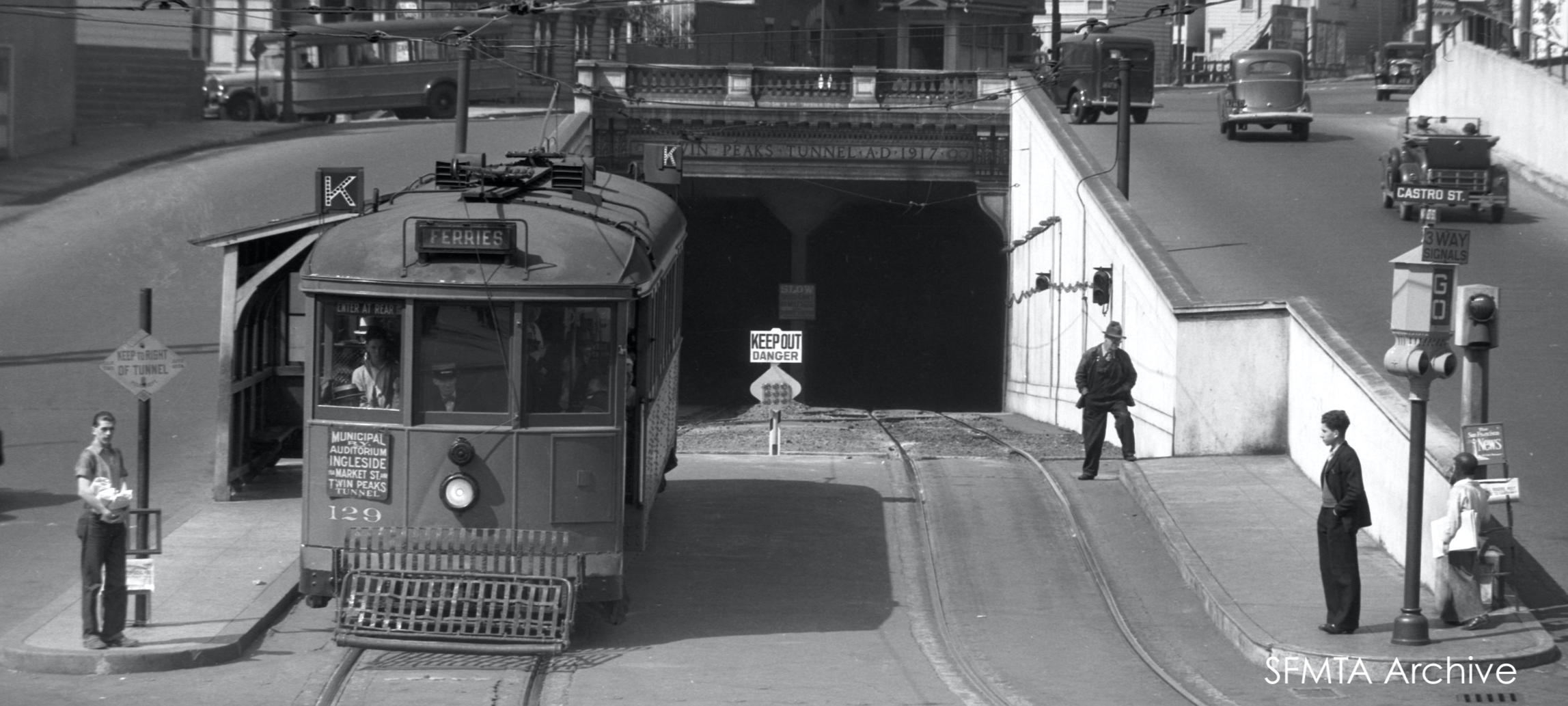
With the additional streetcar service from Muni, the neighborhood around Castro and Market prospered. The streetcars of the 8-line, by then owned by Market Street Railway (MSRy), successor to URR and namesake of our organization, competed with the K and (after 1923) L tunnel cars of the Muni. Together, they provided the largely working-class residents of Eureka Valley with some of the most convenient public transit in the City.

The transit picture diversified in 1935. San Francisco’s first trolley bus line opened: Market Street Railway’s 33-line along 18th Street (shown here at 18th and Castro) and over Twin Peaks to the Haight. It was converted from a streetcar route partly to save money, since the streetcar required two crew members and the bus one. The same year, Muni brought the motor bus to the neighborhood, with what was then called Muni’s 6-Eureka-Diamond line (now essentially the 35-line), running from the now-vanished Eureka Valley station of the Twin Peaks Tunnel (at Market and Eureka) southward up the hill, competing with the Castro cable car. Muni was soon using little White gasoline buses on the line, including No. 042, preserved by Muni with our organization’s help.
Castro Cable’s Odyssey
So in the years just before World War II, the Castro was the only neighborhood in the City served by all four modes of transit: streetcar, trolley bus, motor bus, and cable car. That ended April 5, 1941, when the Castro cable passed into history.
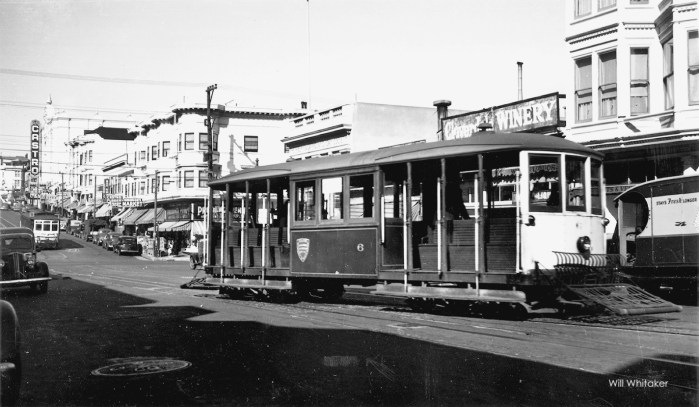
But what a ride it was. The photo above shows Castro Cable Car 6 pulling into its terminal south of 18th Street around 1940, with the Ferry-bound 8-line streetcar across the street, along with the Castro Theater.
The Castro cable cars were rebuilt by Market Street Railway in 1927 into the prosaic design you see above from a rebuild 20 years earlier by United Railroads that was fancier, and even included the stunning open “breezer” below, pictured in 1916, which operated for a number of years on nice days. (Imagine climbing the hill on that!)

This was never a tourist line, though. It provided a connection from Noe Valley to downtown for workers and shoppers … and a great way for a kid to get over the hill by hitching a ride on his bike, as in this 1941 shot at 21st Street.
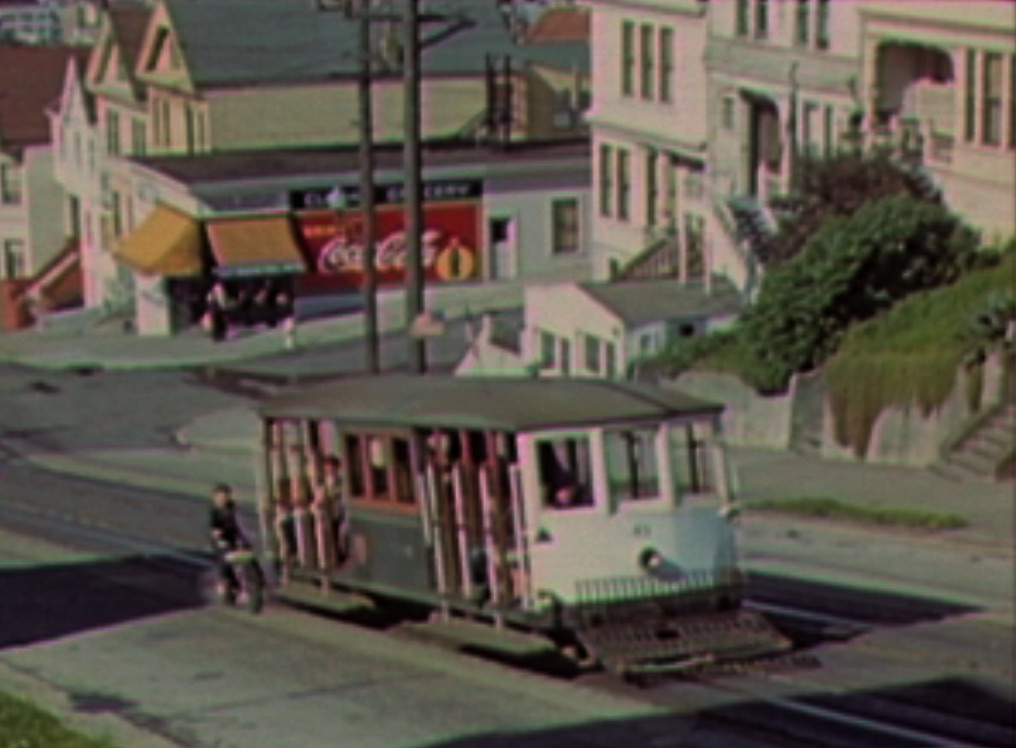
When it closed for good on April 5, 1941, the Castro Cable was mourned by a small but sorrowful group of riders and friends (photo below), replaced by a new crosstown motor bus line, the 24-Divisadero. There was neighborhood support for keeping the cable cars, but the line was losing buckets of money, and the private operator could not sustain the losses.

Sadly, no Castro cable cars were preserved, but Muni recently restored a near-twin from the Sacramento-Clay line (abandoned in 1942), which now operates on special occasions on California, Mason, or Hyde streets.
During the War, rationing of gasoline and rubber tires caused a national boom in transit ridership. Both Muni and MSRy ran their streetcars into the ground (literally in a few cases, when rotten platforms fell off). In 1944, after saying ‘no’ several times over the years, San Francisco voters okayed the public purchase of MSRy, which was consolidated into Muni, lock, stock, and streetcars. As the war ended, it was clear the equipment would have to be replaced, but with what?
The decision came down to convert all of the old MSRy streetcar lines, and some of Muni’s, to bus operation: trolley bus in most cases, to take advantage of the overhead wires and poles already in place as well as cheap City-owned Hetch Hetchy hydro power. In fact, all the streetcar lines might have been scrapped if the Twin Peaks Tunnel and the N-line’s Sunset Tunnel had been wide enough for buses.
Steel wheels to rubber tires

After 43 years of running by the Castro Theater, the 8-line lost its streetcars in 1949, replaced by trolley coaches. The outer streetcar tracks on Market had already been removed, and Muni’s K, L, and M lines took over the 8’s familiar spot in the center of Market. The tracks on Castro were removed too. (In the 1937 shot above, the 8 car switches tracks at its terminal, in front of what’s now Cliff’s Variety. In the 1976 shot directly below, trolley coach 776 is in the exact same spot, with Cliff’s on the far right. That 1950 bus, painted at the time for the national bicentennial, was preserved by Market Street Railway and Muni now runs it on special occasions. The shot below that dates to 1973 and shows how the block of Castro between Market and 18th looked from about 1950 until the street was redone around 2017.)


On Market Street itself, the Art Deco-style “PCC” streetcars had finished replacing the drafty boxy original Muni streetcars by 1958. (The photo below shows one of Muni’s original streamliners at Castro and Market in 1959. In case you’re wondering, the gas station has been at that location since the early 1920s!) With upholstered seats and a springy suspension, the modern streetcars attracted a loyal following among Castro riders, and were the City’s streetcar standard for 30 years.

Muni Metro Suffers Birth Pains
In the 1970s, Muni finally built the Market Street subway that had been dreamed about since the 1910s. It connected directly to the Twin Peaks Tunnel, obliterating the old East Portal at Castro.
During the protracted construction, though, Muni had to keep running the PCCs, because there weren’t enough buses to substitute. The streetcars were moved off Market, so the subway between Duboce and Castro could be built easily. The “temporary” streetcar detour included new tracks on 17th Street (still there!) between Church and Castro.

Building the Castro Metro Station while streetcar service continued was more complex. The streetcars had to wind back and forth on trestle track above the station excavation to gain temporary access to the tunnel. Wags called it the ‘Collingwood Elevated,’ for the side street it blocked, but the neighbors on that street and others nearby had more pungent names for it. After station construction was finished in the late 1970s, “temporary” portals shored up with steel and wood retaining walls (also still there) gave the K, L, and M line streetcars access to the Twin Peaks Tunnel, until the subway could open (it was delayed several years).

During this period, of course, the neighborhood was going through more profound changes than any transit line could bring. The earlier generations of immigrants that originally populated the district, largely German and Irish, were gone, and their children and grandchildren were migrating to the suburbs.
A new wave of immigration was sweeping the neighborhood, predominantly gay men, drawn by the City’s relative openness and the attractive (if somewhat down at the heels) housing in the area.
The new residents transformed the neighborhood in many ways, restoring its vintage homes, bringing new life to the street scene, even discarding the old name. No one called it Eureka Valley anymore. It was the Castro now., complete with its own Muni Metro station.
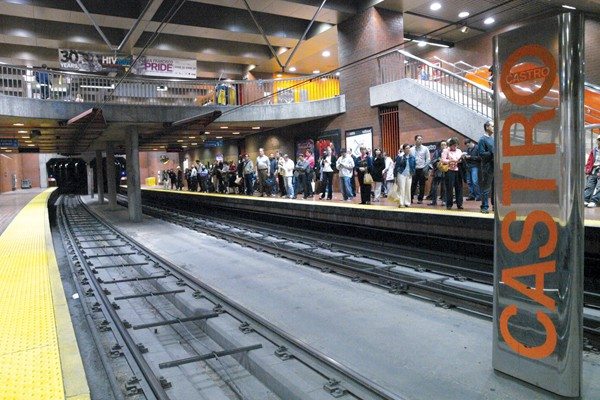
The Trolley Festival: 1983

It looked like surface streetcar service to Castro was history when the last ‘green torpedoes’ pulled into the barn in September 1982. But an unusual coalition of downtown business, Upper Market merchants, and Castro residents, organized by members of our nonprofit Market Street Railway, put together something called the Historic Trolley Festival, to operate restored Muni antiques and vintage streetcars from around the world on the Market Street tracks to provide a ‘substitute attraction’ for the cable cars, then being rebuilt. That’s Mayor Dianne Feinstein, opening the first festival on May 27, 1983 aboard Muni’s very first streetcar from 1912, Car 1, at 17th and Castro. It was supposed to be a one-year thing, but its popularity among Upper Market residents, many of whom preferred the old cars to the crowded Metro or the 8-line bus, called for its return. It ran five summers in all, with a mix of streetcars from around the US and the world, including the 1905 Council Crest streetcar from Portland, Oregon, below.

The permanent F-line: 1995
The great success of the Trolley Festivals led to the construction of the F-line, with Castro providing the western anchor of the operation. The opening event on September 1, 1995, featured the popular open-top Blackpool, England boat tram, but basic service has been provided by popular PCC streetcars, painted to honor the various cities that once operated this historic vehicle type.

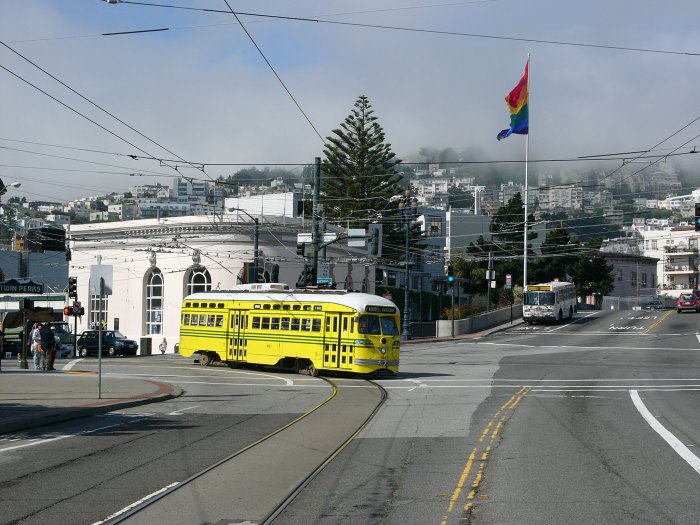
The F-line replaced the 8-line trolley coaches, and was immediately so popular that Muni realized it would need additional cars to operate the planned extension to Fisherman’s Wharf. Muni acquired ten 1928-vintage trams from Milan, Italy, and opened The Embarcadero extension on March 4, 2000, providing direct service from the Castro to Fisherman’s Wharf for the first time. The F-line has proven to be a big help to the small businesses of the Castro and all along its route.
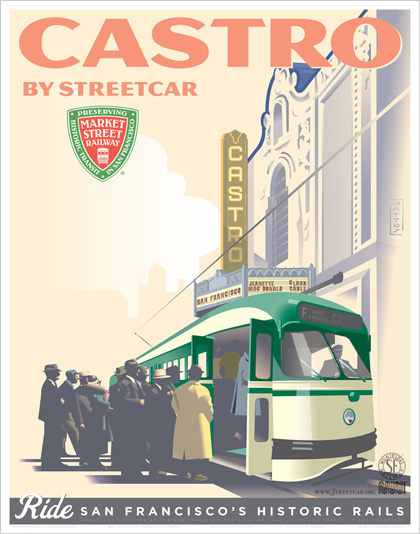
We at Market Street Railway are proud members of the Castro Merchants and have many supporters in the neighborhood, with the Twin Peaks Tavern next to the F-line terminal being one of our longest-standing business members.
We are also proud to offer a number of great Castro-themed products, part of our exclusive Historic Travel Series, at our online store and our museum. We at Market Street Railway are proud members of the Castro Merchants and have many supporters in the neighborhood, with the Twin Peaks Tavern next to the F-line terminal being one of our longest-standing business members.
So the Castro has seen a great deal of transit change and social change as well. But thanks to the F-line, one constant remains. When Castro residents head downtown, they ride the rails of Market Street, just as their predecessors have for more than 130 years.